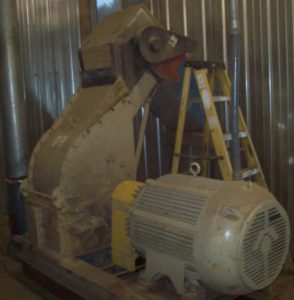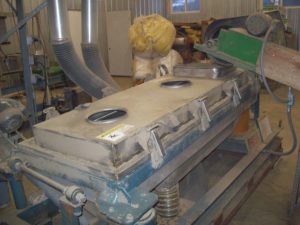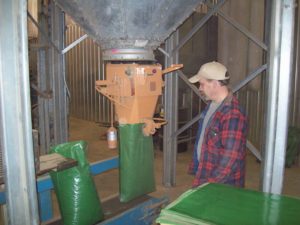Where the Green Grass Grows: Local, Renewable Fuel
A NEW VENTURE
How did May and Bob Miller go from dairy farming to making grass pellets? They had always been interested in “green” energy, but when fuel prices started to rise in 2008, they saw new potential in the growing acreage owned by non-farming landowners surrounding their home in Delaware county. With the goal of turning idle land into a renewable fuel, they set out to launch their new business venture: making grass pellets. Approximately the size of grain pellets (~1/8” in diameter and ~1/2” long), grass pellets can be burned in stoves to provide heat or electricity. While researching grass pellets, the Millers traveled to Canada because they had heard that it was feasible to pellet grass there. They learned that no one was making pellets for local home energy use: Canadian pellets were marketed for horse bedding or for coal plants. The Millers continued to research the pellet industry in theUnited States, paying attention to what was working and what wasn’t working. “We thought we could see where it could be done better,” says May, so they bought some old wood pelleting equipment and began experimenting. In partnership with their son, May and Bob created EnviroEnergy LLC in the summer of 2008.
TRIAL-AND-ERROR
The learning curve turned out to be much longer and steeper than the Millers anticipated. For example, they had to figure out how to make dense enough pellets and determine the appropriate moisture content for their raw materials. They’ve received great support from Cornell Cooperative Extension inDelawareCounty, which received funding to install pellet stoves about the same time that Millers began pelleting grass. Other support has come from theDelawareand Otsego County Offices of Economic Development. After many rounds of trial and error, EnviroEnergy has been making successful pellets since early 2009.
LOCAL OPPORTUNITY
Pelleting grass has turned out to be a perfect enterprise for these independent-minded retired dairy farmers. DelawareCounty’s newest crop of residents is largely composed of people from downstate who often hire farmers to mow their fields rather than allow them to become overgrown. EnviroEnergy can purchase this grass – they pay $60/ton for delivered hay – and make pellets. They plan to keep the business operating within a 40-50 mile radius because they enjoy working with local farmers and developing local markets for their pellets. May says that because of the available grass, high fuel prices, and increasing interest in sustainability, “this is a very good product for this area.”
ROOM FOR GROWTH
All of the pellets made since the Millers began pelleting have been sold and used successfully, but there’s a lot of room for growth. Grass pellets have a higher ash content than their wood counterparts, and while some wood pellet stoves can burn grass pellets, some can’t. May and Bob keep track of which stoves work for their customers and recommend contacting Cornell researcher Dr. Jerry Cherney for more information about pellet-burning stoves. As stoves designed to burn grass become available, the market for grass pellets will improve. May thinks that pelleted grass is a good fuel alternative in the Northeast: there’s ample opportunity for local pelleting businesses and grass pellets produce 90% less emissions than allowed by the EPA.
A ‘MULTI-PURPOSE’ PELLET?
Local consumers can purchase grass pellets from EnviroEnergy at $225/ton or $4.50/40-pound bag. Though the Millers are focused on making pellets that burn well, some customers are coming up with alternative uses. Some use grass pellets for cat litter or horse bedding and love the product’s absorbency. A nursery tried and failed to germinate weed seeds in the pellet material and may explore using pellets as mulch or in a potting soil mix. Whatever the application, the Millers are committed to producing a quality product.
Learn more about EnviroEnergy LLC here. Learn more about energy resources for small farms here.





Is there any further information available about making electricity with these grass pellets? I think this is a great idea and resource for renewable energy and would like to look into it further.